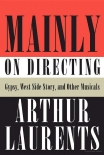Mainly on Directing, Arthur Laurents [best books for students to read TXT] 📗

- Author: Arthur Laurents
Book online «Mainly on Directing, Arthur Laurents [best books for students to read TXT] 📗». Author Arthur Laurents
We were both in Hollywood when I met Tom and, for the moment, was resisting joining my life with his. Jerry more than approved of Tom, Tom was what I needed, but I was resisting and set to return to New York. Jerry forestalled that by insisting I stay with him—ostensibly to talk about West Side Story—in the Beverly Hills house he was renting while he did The King and I for the movies. That eliminated my excuse for having to go back to New York.
I have always remembered Jerry and me being close in those days, but I didn't know how close until, clearing out some files, I came across a long letter from Jerry dated October 6, 1955. Instead of mailing it to me in New York, he was sending it via Tom, who was moving there to live with me, because he thought it would reach me faster. How slow was air mail in 1955?
“I will sure be sorry to see Tom leave,” he wrote, “but as he says, what a wonderful Christmas we are all going to have together in New York and I do look forward to the fact that both of you will make New York a happier place to be in.” Jerry Robbins wrote that, a Jerry Robbins I don't remember.
The Jerry I do remember turns up in what he writes about “ROMEO” (aka West Side Story)—how he has waited seven years for Lenny and me to sit down and start writing but he didn't mind because he wouldn't have wanted anyone else. And, much to my surprise, about my play A Clearing in the Woods. In his version, he loved the play and wanted badly to direct it but I held him off; in my version, he backed out of directing it. Which is true? How would I know?
The last paragraph of the letter is written by the Jerry Robbins who wrote the first, the Jerry I don't remember. “Write me, bubby [sic], and tell me all. I envy you the Fall in New York, the life in Quogue, but I am happy for all the happiness that you will be having. With all my love, Jerry.” Those were the days. Those are the days that we miss, that are the best, that we should never forget, but memory, like success, can be a spoiler.
When West Side Story finally happened and succeeded, Jerrys excessive need for recognition went into high gear, slowing down only when McCarthyism struck him. That added to the disintegration of our relationship, already under way. Those memories are too sharp.
On the occasion of a birthday party he was giving himself, he asked Nora Kaye, known variously as the Duse of the Dance or the Red Ballerina and rumored at various times to be marrying Jerry and/or me: “Do I have to invite Arthur?”
When Ahmet Ertegun, the record mogul, gave him a party for his seventy-fifth birthday, Jerry called me at really the last minute and said grumpily: “I know you know it's the last minute but I'd like you to come.” I went and had a good, if strange, time. It was a huge party at Maxim's in New York: black tie; champagne like tap water; two tables of show folk, two hundred tables of big money and big celebrities; an orchestra; dancing; entertainment; speeches; and—finally—Jerry. He spoke of late-nightly meetings with his neighbor Mica Ertegun, Ahmet's famous interior-decorating wife, as they walked their dogs, Jerry alone, always alone—“I'm a loner,” he said wistfully. Sitting with the show folk was his ignored lover, Jesse Gerstein, a photographer. Phyllis Newman said, “If I had a gun, I'd shoot Jerry right now.” Jesse died of AIDS at the age of thirty-four.
Our professional relationship wasn't smooth, but it was always characterized by mutual respect. He may have had to make himself drive over to my house in Quogue from his in Watermill to ask— Jerome Robbins asking!—for my help with his Jerome Robbins' Broadway, but drive over he did. The reunion wasn't without laughter. And tears, actual, visible, from him when I said I would trust him (about royalties). I gave him as much help as I could with his show, for which he was very appreciative.
When the gaggle of producers on Nick & Nora added my refusal to fire Tina Paul, our choreographer, to the weekly water-boarding they gave me, I called Jerry and asked if he would come see the show. Tina's work with a company of nondancers impressed him. And the show? He liked it, but … But what? Something, he didn't know what, was wrong. We talked at length, as only friends do. Neither of us could figure out what that something was, but there was something.
Too late, I figured out what it was; but it would have been too late at the outset. The musical was based on the Thin Man movies starring William Powell and Myrna Loy as Dashiell Hammett's famous characters Nick and Nora Charles. Except that by the time the musical was being birthed, Nick and Nora Charles weren't as famous as William Powell and Myrna Loy; in fact, they no longer existed. The world knew the Thin Man movies only as the lubricated adventures of William Powell and Myrna Loy. The actors in the musical, no matter how good Joanna Gleason and Barry Bostwick were—and they were very good—didn't have a chance. That was the





Comments (0)